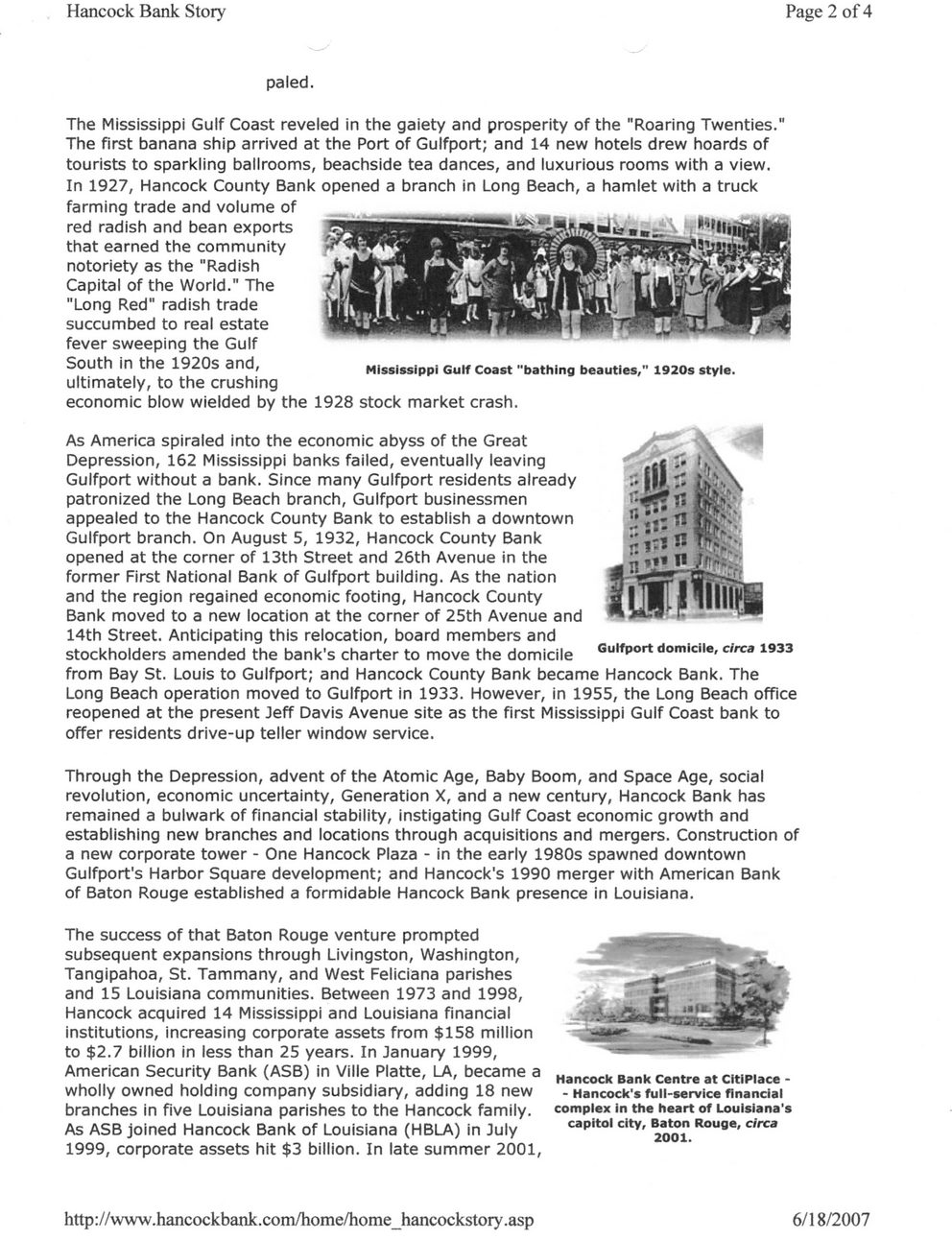This text was obtained via automated optical character recognition.
It has not been edited and may therefore contain several errors.
Hancock Bank Story Page 2 of 4 paled. The Mississippi Gulf Coast reveled in the gaiety and prosperity of the "Roaring Twenties." The first banana ship arrived at the Port of Gulfport; and 14 new hotels drew hoards of tourists to sparkling ballrooms, beachside tea dances, and luxurious rooms with a view. In 1927, Hancock County Bank opened a branch in Long Beach, a hamlet with a truck farming trade and volume of red radish and bean exports that earned the community notoriety as the "Radish Capital of the World." The "Long Red" radish trade succumbed to real estate fever sweeping the Gulf South in the 1920s and, ultimately, to the crushing economic blow wielded by the 1928 stock market crash. - #-a fp S':*» As America spiraled into the economic abyss of the Great Depression, 162 Mississippi banks failed, eventually leaving Gulfport without a bank. Since many Gulfport residents already patronized the Long Beach branch, Gulfport businessmen appealed to the Hancock County Bank to establish a downtown Gulfport branch. On August 5, 1932, Hancock County Bank opened at the corner of 13th Street and 26th Avenue in the former First National Bank of Gulfport building. As the nation and the region regained economic footing, Hancock County Bank moved to a new location at the corner of 25th Avenue and 14th Street. Anticipating this relocation, board members and stockholders amended the bank's charter to move the domicile from Bay St. Louis to Gulfport; and Hancock County Bank became Hancock Bank. The Long Beach operation moved to Gulfport in 1933. However, in 1955, the Long Beach office reopened at the present Jeff Davis Avenue site as the first Mississippi Gulf Coast bank to offer residents drive-up teller window service. Gulfport domicile, circa 1933 Through the Depression, advent of the Atomic Age, Baby Boom, and Space Age, social revolution, economic uncertainty, Generation X, and a new century, Hancock Bank has remained a bulwark of financial stability, instigating Gulf Coast economic growth and establishing new branches and locations through acquisitions and mergers. Construction of a new corporate tower - One Hancock Plaza - in the early 1980s spawned downtown Gulfport's Harbor Square development; and Hancock's 1990 merger with American Bank of Baton Rouge established a formidable Hancock Bank presence in Louisiana. The success of that Baton Rouge venture prompted subsequent expansions through Livingston, Washington, Tangipahoa, St. Tammany, and West Feliciana parishes and 15 Louisiana communities. Between 1973 and 1998, Hancock acquired 14 Mississippi and Louisiana financial institutions, increasing corporate assets from $158 million to $2.7 billion in less than 25 years. In January 1999, American Security Bank (ASB) in Ville Platte, LA, became a wholly owned holding company subsidiary, adding 18 new branches in five Louisiana parishes to the Hancock family. As ASB joined Hancock Bank of Louisiana (HBLA) in July 1999, corporate assets hit $3 billion. In late summer 2001, Hancock Bank Centre at CitiPlace -- Hancock's full-service financial complex in the heart of Louisiana's capitol city, Baton Rouge, circa 2001. http://www.hancockbank.com/home/home_hancockstory.asp 6/18/2007

Hancock Bank History-(Hancock-Bank)-3